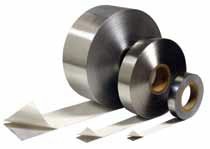For optimum adhesion, an adhesive must thoroughly “wet out” the surface to be bonded. To wet out a surface(substrate) the adhesive must flow and cover the suface, which allows for maximum contact area between the adhesive and the surface (substrate).
Think of a bead of water on a car. On a freshly waxed car, the water beads up and covers a smaller surface area. On an unwaxed car, the water spreads more across the surface. By waxing the car, the surface energy of the car’s surface has changed and does not allow the bead of water to cover as much area.
In order for a pressure sensitive adhesive to achieve wet out on a surface and ultimate adhesion, one must understand the surface energy of the substrate. The table below lists typical surface energies of commonly used substrates:
|
VERY HIGH SURFACE ENERGY
|
HIGH SURFACE ENERGY
|
LOW SURFACE ENERGY
|
Nova Films & Foils has developed adhesives especially for adhesion to low surface energy (LSE) substrates. These specialized adhesives can achieve a strong bond to LSE substrates without the end user adding surface modifiers such as primers or corona treatment. Have questions about the surface energy of your substrate? Call us at Nova Films & Foils to discuss your application and substrates.


